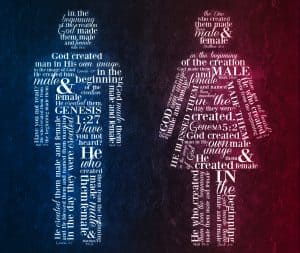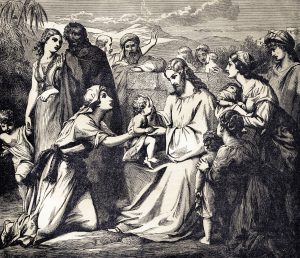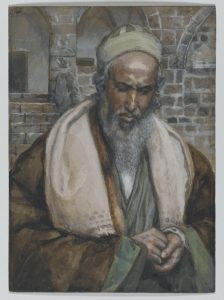From God creating us male and female and ordering marriage toward procreation, to Jesus’ reaffirmation of natural marriage in Matthew 19, to Paul’s clear language in his epistles, to the marriage supper of the Lamb, not to mention the way the Old Testament dealt with sexuality and sexual sin, the Bible consistently and unambiguously teaches one view of human sexuality. Marriage is so thoroughly woven into the story of redemption, any attempt to alter it distorts the Gospel.
—John Stonestreet—
This article combines the content of parts 8, 9, and 10 of this series.
Key point: When the Pharisees asked Jesus about divorce, Jesus replied by reminding them about the history, nature, meaning, and significance of marriage. Christians need to rediscover and heed these same teachings today.
Before Father Knows Best was a television program, it was a radio show. Jim Anderson, the father of three growing children—Betty, Bud, and Kathy—and husband to Margaret, may not always have known best in the absolute sense, but he undeniably was a loving father, even though at times with a rough exterior and with obvious imperfections.
You can learn more about Father Knows Best here.
Peggy Ann Garner and Ted Donaldson in A Tree Grows in Brooklyn, released in 1945, four years before the radio premiere of Father Knows Best
On the radio episode airing January 12, 1950, Bud Anderson, played by Ted Donaldson, is excited to tell his dad about the new watch his friend Joe Phillips got for Christmas.
Bud: You outta see the watch Joe Phillips got for Christmas, Dad. Boy, is that a watch! Shatterproof, shockproof, waterproof, heatproof, and it’s guaranteed to last him a lifetime. But it won’t.
Dad: Why not?
Bud: He lost it.
Dad: Bud, instead of making bad jokes, why don’t you go upstairs and do your homework?
Bud: That wasn’t a joke, Dad.
Dad: You can say that again!
Bud: You mean he whole thing?
Dad: Bud!
As humorous as this exchange is, I believe it illustrates a point we dare not miss. Whenever we lose something, we also lose its benefits.
Whenever we lose something, we also lose its benefits.
Unfortunately, this is exactly what is going on in society with regard to marriage! The culture is losing a clear understanding of what natural marriage is, and in the process, it is losing the benefits marriage brings.
The church must help society recover what it has lost, and it must start at its own doorstep!
- It must seek to convey to its own members—especially young believers—how marriage is woven into the fabric of the gospel.
- It must uphold man-woman marriage and articulate the benefits it brings to both individuals and society.
- Finally, it must issue warnings both within and beyond its walls about how redefining marriage not only removes benefits but also produces harmful consequences. For example, even though same-sex partners can be good parents in many ways, redefining marriage to include them necessarily means their adopted children will be deprived of either a mom or a dad. A man cannot be a mother; nor can a woman be a dad. Children need two parents, one of each sex. Moreover, while it’s true that single-parent households exist and that in many of them one parent is totally out of the picture, even in these households the concept and ideal of two opposite-sex parents survives.
Of course, God’s people must never abandon or diminish their primary mission of sharing the gospel and making disciples. Still, marriage and the gospel are so intertwined that to refuse to uphold natural marriage is to diminish and hinder the gospel itself.
Marriage and the gospel are so intertwined that to refuse to uphold natural marriage is to diminish and hinder the gospel itself.
Jesus Upheld Natural Marriage
In Matthew 19:3, the Pharisees approached Jesus and asked Him a question to trap Him. “Is it lawful,” they asked, “for a man to divorce his wife for just any reason?” Jesus’ answer to them is very instructive for the church with regard to the true meaning of marriage, so as we examine Jesus’ words, we’ll focus on that. You can read the passage in its context, along with the parallel passage in Mark’s Gospel, here. Matthew 19:4-6 records Jesus’ response to the Pharisees.
4 And He answered and said to them, “Have you not read that He who made them at the beginning ‘made them male and female,’ 5 and said, ‘For this reason a man shall leave his father and mother and be joined to his wife, and the two shall become one flesh’? 6 So then, they are no longer two but one flesh. Therefore what God has joined together, let not man separate.”
Let’s examine nine elements in this passage.
Haven’t You Read?
First, it is significant that Jesus asked, “Have you not read…?” With this powerful rhetorical question, the Master Teacher emphasized to the Jewish leaders they already should have known the answer to their question. This wasn’t the only time Jesus asked this question of His hearers. He also asked it on several other occasions, in situations related to these themes or events.
- Jesus is Lord of the Sabbath (see Matthew 12:1-8; Mark 2:23-28; Luke 6:1-5)
- The Cleansing of the Temple (see Matthew 21:12-17; Mark 11:15-19; Luke 19:45-48)
- The parable of the wicked vinedressers (see Matthew 21:33-46; Mark 12:1-12; Luke 20:9-19)
- The Sadducees ask Jesus about the resurrection (Matthew 22:23-33; Mark 12:18-27; Luke 20:27-40)
In all five of these instances—the four in the bulleted list above plus the one relating to marriage and divorce—Jesus asked, “Have you not read?” or something similar for a very important reason. His hearers should have known more than their questions or actions demonstrated they knew.
I am not saying the leaders of the modern American evangelical church are Pharisees or pharisaical. Still, I am compelled to suggest that were our Lord here in the flesh in 2017, He very well might survey the cultural landscape in relation to the meaning of marriage, look evangelical leaders piercingly in the eye, and say to them the very same thing He said to the Pharisees in Matthew 19:4-6:
“Have you not read that He who made them at the beginning ‘made them male and female,’ and said, ‘For this reason a man shall leave his father and mother and be joined to his wife, and the two shall become one flesh’? So then, they are no longer two but one flesh. Therefore what God has joined together, let not man separate.”
Why would He do this? Sadly, the inaction of the evangelical church in relation to the definition of marriage makes one wonder (1) if evangelicals have read the passages Jesus quotes and (2) if they really believe them!
Sadly, the inaction of the evangelical church in relation to the definition of marriage makes one wonder (1) if evangelicals have read the passages Jesus quotes and (2) if they really believe them!
Please know that in no way am I trying to disparage anyone. I’m simply trying to challenge my brothers and sisters in Christ on this issue, especially in light of recent surveys on what people now think about same-sex marriage (see the information in this article under the heading “The Situation is Desperate”). As we said earlier, when we lose something, we also lose it’s benefits. Finding it means regaining those benefits. For the church, being reminded of Jesus’ strong affirmation of marriage is a first step in helping society rediscover the true meaning of marriage and all the advantages flowing from it.
For the church, being reminded of Jesus’ strong affirmation of marriage is a first step in helping society rediscover the true meaning of marriage and all the advantages flowing from it.
Back to Genesis
 Second, it is noteworthy that Jesus quotes Genesis in His answer. He combines Genesis 1:27 and 5:2 with Genesis 2:24. You can read all three of these verses in context, along with Jesus’ words as recorded in Matthew and Mark, here. We will focus on Matthew’s account of Jesus’ quotation.
Second, it is noteworthy that Jesus quotes Genesis in His answer. He combines Genesis 1:27 and 5:2 with Genesis 2:24. You can read all three of these verses in context, along with Jesus’ words as recorded in Matthew and Mark, here. We will focus on Matthew’s account of Jesus’ quotation.
- Genesis 1:27 in its entirety reads, 27 “So God created man in His ownimage; in the image of God He created him; male and female He created them.”
- Genesis 5:2 says, “He created them male and female, and blessed them and called them Mankind in the day they were created.”
- Genesis 2:24 says, “Therefore a man shall leave his father and mother and be joined to his wife, and they shall become one flesh.”
Again, Jesus responded to the Pharisees by saying this. (We have underlined the quoted portions.)
“Have you not read that He who made them at the beginning ‘made them male and female,’ [Gen. 1:27 and 5:2] 5 and said, ‘For this reason a man shall leave his father and mother and be joined to his wife, and the two shall become one flesh’ [Gen. 2:24]? 6 So then, they are no longer two but one flesh. Therefore what God has joined together, let not man separate” (Matt. 19:4-6).
Note that Jesus quoted from the earliest words recorded in the first book of the Bible. Jesus was referring to the Hebrew Scriptures, but Genesis also is the first book in Orthodox, Catholic, and Protestant Bibles as well. Not every book in the Bible is chronically arranged, but the placement of Genesis first is indeed chronologically correct. Certainly the earliest chapters of the book reflect the earliest events of recorded history.
The Pharisees believed the Old Testament to be inspired by God. They emphasized the importance of obeying the it as well as oral traditions. They went “by the Book.” Thus, if the Pharisees were familiar with any portion of the Old Testament, they certainly should have been familiar with the statements Jesus quoted.
While I am not accusing evangelical leaders of being Pharisaical in the sense of having prideful attitudes, I must point out that we also ought to be familiar with the Old Testament words Jesus quoted. Moreover, we ought to understand their meaning and significance.
From the Beginning
 Third, Jesus explicitly said “He who made them at the beginning ‘made them male and female” (emphasis added). The fact that to be human means, inherently, to be either male or female is a truth as old as time itself. In creating humanity as male and female, God effectively established marriage as an institution. Indeed, as we read further in Genesis, and as we continue to read Jesus’ statements in Matthew 19, this is exactly what we will find.
Third, Jesus explicitly said “He who made them at the beginning ‘made them male and female” (emphasis added). The fact that to be human means, inherently, to be either male or female is a truth as old as time itself. In creating humanity as male and female, God effectively established marriage as an institution. Indeed, as we read further in Genesis, and as we continue to read Jesus’ statements in Matthew 19, this is exactly what we will find.
It is entirely appropriate, therefore, that the authors of the Pledge in Solidarity to Defend Marriage would emphasize the foundational nature of humanity as male and female in the pledge’s opening paragraphs.
We stand together in defense of marriage and the family and society founded upon them. While we come from a variety of communities and hold differing faith perspectives, we are united in our common affirmation of marriage.
On the matter of marriage, we stand in solidarity. We affirm that marriage and family have been inscribed by the Divine Architect into the order of Creation. Marriage is ontologically between one man and one woman, ordered toward the union of the spouses, open to children and formative of family. Family is the first vital cell of society, the first government, and the first mediating institution of our social order. The future of a free and healthy society passes through marriage and the family.
Marriage as existing solely between one man and one woman precedes civil government. Though affirmed, fulfilled, and elevated by faith, the truth that marriage can exist only between one man and one woman is not based on religion or revelation alone, but on the Natural Law, written on the human heart and discernible through the exercise of reason. It is part of the natural created order. The Natural Law is what Dr. Martin Luther King, Jr., referred to as a higher law or a just law in his famous Letter from Birmingham Jail.
Marriage is the preeminent and the most fundamental of all human social institutions. Civil institutions do not create marriage nor can they manufacture a right to marry for those who are incapable of marriage. Society begins with marriage and the family.
We pledge to stand together to defend marriage for what it is, a bond between one man and one woman, intended for life, and open to the gift of children.
We see, then, that the meaning of marriage as a commitment of one man and one woman arises naturally from the fact that human beings have been created and exist as male and female individuals. This is the created order, and it was, as Jesus said, at—and thus it has been since—the beginning.
“For this Reason”
Fourth, Jesus’ use of the phrase “for this reason” is extremely important. Read again the background passages along with Jesus’ response to the Pharisees here. For your convenience, we present once more Jesus’ reply to the Pharisees as recorded in Matthew 19:4-6, with the portions Jesus quoted from the Old Testament underlined.
Have you not read that He who made them at the beginning “made them male and female,” [Gen. 1:27 and 5:2] 5 and said, “For this reason a man shall leave his father and mother and be joined to his wife, and the two shall become one flesh” [Gen. 2:24]? 6 So then, they are no longer two but one flesh. Therefore what God has joined together, let not man separate.
It is entirely fitting for Jesus to place Genesis 1:27 and 5:2 alongside Genesis 2:24, even though the prepositional phrase “For this reason” [which comes from Gen. 2:24] clearly refers to what came before it originally, the statements immediately prior to it in Genesis 2. Here are those statements, along with verses 24 and 25.
18 And the Lord God said, “It is not good that man should be alone; I will make him a helper comparable to him.” 19 Out of the ground the Lord God formed every beast of the field and every bird of the air, and brought them to Adam to see what he would call them. And whatever Adam called each living creature, that was its name. 20 So Adam gave names to all cattle, to the birds of the air, and to every beast of the field. But for Adam there was not found a helper comparable to him.
Adam in the garden of Eden, as depicted at the Creation Museum
21 And the Lord God caused a deep sleep to fall on Adam, and he slept; and He took one of his ribs, and closed up the flesh in its place. 22 Then the rib which the Lord God had taken from man He made into a woman, and He brought her to the man.
23 And Adam said:
“This is now bone of my bones
And flesh of my flesh;
She shall be called Woman,
Because she was taken out of Man.”
24 Therefore a man shall leave his father and mother and be joined to his wife, and they shall become one flesh.
25 And they were both naked, the man and his wife, and were not ashamed (Gen. 2:18-25).
Made for Each Other
Essentially, Jesus summarized Genesis 2:18-23 with these words, the bolded portion of which comes from Genesis 1:27 and 5:2: “He who made them at the beginning ‘made them male and female’” (Matt. 19:4). This is exactly what Genesis 2:18-23 tells us!
For what reason, then, shall a man “leave his father and mother and be joined to his wife, and the two shall become one flesh” (Gen. 2:24; Matt. 19:4-5; Mark 10:6-8)? The answer is clear. It first is stated in Genesis and then restated by Jesus in Matthew and Mark: Because God created human beings as male and female! Bible scholar William Hendriksen puts it this way: In Genesis 2:24,
God ordains that for this very reason—that is, because the union between the two was intended to be so intimate and they were designed for each other (see both Gen. 1:27 and 2:23)—a man shall leave his father and his mother, and shall do this with a view to a more intimate and more lasting attachment, namely, “and shall cleave to his wife, and the two shall be one flesh”; yes, “no longer two but one flesh,” says Jesus1 [emphasis added].
Why shall a man leave his father and mother and be joined to his wife, and the two become one flesh? Because God created human beings as male and female!
A man and a woman are alike in that each is human; yet each is different from the other in both obvious and subtle ways. Significantly, God said, “It is not good that man should be alone; I will make him a helper comparable to him” (Gen. 2:18). Because a man and a woman are different, they are compatible. I don’t mean that any man is compatible with any woman in the same way we think of relational compatibility for a specific couple. I mean generally speaking, the differences between men and women make a man and woman suitable for each other in a marriage relationship.
 Male-female differences enhance curiosity, augment relational chemistry, and intensify attraction between two members of the opposite sex. We can sense at least some of these elements in Edmund Leighton’s painting Courtship. Go here to see additional works by Leighton that showcase the healthy tension and even mystery unique to opposite-sex relationships.
Male-female differences enhance curiosity, augment relational chemistry, and intensify attraction between two members of the opposite sex. We can sense at least some of these elements in Edmund Leighton’s painting Courtship. Go here to see additional works by Leighton that showcase the healthy tension and even mystery unique to opposite-sex relationships.
Male-female differences also set the stage for a husband and wife to be an effective team, not only in ways that benefit each other, but also in ways that meet the needs of any children born as a result of their union. Yes, these differences can be a source of great frustration as well, but as a couple works through the obstacles together, their bond becomes stronger, deeper, and more intimate. We do not have any of this with same-sex couples.
Only a Heterosexual Union Can Reflect Unity and Diversity Within the Godhead
Fifth, Jesus went on to say, “So then, they are no longer two but one flesh.” Having quoted Genesis 2:24 in Matthew 19:5, the Master Teacher underscored the “one-flesh principle” of man-woman marriage in 19:6. A husband and wife are to become one flesh, not just physically, but on many levels, including relationally, socially, financially, and in other ways as well. While a married person’s individuality does not cease, it no longer has independence as its primary focus, but oneness with the marital partner.
We could say a great deal about this, but here we want to emphasize this point: Marital oneness reflects the oneness we see in the triune Godhead. In John 10:30, Jesus said, “I and My Father are one.” Jesus is God, but He is neither the Father nor the Spirit. In a variety of ways, He is different from each one. Yet there is unity among the Trinity’s Members.
We see evidence of the Trinity even before God made human beings. On the cusp of creating humanity, the Father, Son, and Holy Spirit discussed the matter.
26 Then God said, “Let Us make man in Our image, according to Our likeness; let them have dominion over the fish of the sea, over the birds of the air, and over the cattle, over all the earth and over every creeping thing that creeps on the earth.” 27 So God created man in His own image; in the image of God He created him; male and female He created them. 28 Then God blessed them, and God said to them, “Be fruitful and multiply; fill the earth and subdue it; have dominion over the fish of the sea, over the birds of the air, and over every living thing that moves on the earth” (Gen. 1:26-28).
Within the Godhead, as we have indicated, we see both unity and diversity. Not coincidentally, while both men and women are equal in worth and are equally made in God’s image, men reflect His image in a variety of ways that women typically do not, and vice versa. Let’s put it another way. Men and women are both human, yet they are different (also go here, here, and here); there is unity and diversity among them. These are God’s “fingerprints” on His highest creation! The fact that human beings consist of both males and females represents not only the wide range of ways people showcase God’s image, but also the unity and diversity that coexists within the Godhead.
These truths lead us to an inescapable conclusion. While all people, both males and females, are made in God’s image, the one-flesh nature of man-woman marriage reflects His image in ways no individual man or woman can—and in ways no same-sex couple can, whether the state says they are “married” or not. Here we are in no way equating singleness with same-sex marriage. Rather, we’re upholding man-woman marriage as uniquely able to reflect the broad range of ways God’s image is evident in human beings. This is especially critical for children, whose first impressions about God come from their parents.
The one-flesh nature of man-woman marriage reflects God’s image in ways no individual man or woman can—and in ways that no same-sex couple can, whether the state says they are “married” or not.
Scriptural Context Offers an Additional Insight
Sixth, it is noteworthy that the next encounter Jesus had, as recorded in Matthew and Mark, involved children. Jesus did speak briefly to His disciples about celibacy on the heels of his conversation with the Pharisees (see Matt. 19:11-12 in the parallel passages we just cited), but this teaching readily can be seen as the last portion of His teaching on marriage and divorce, which had been prompted by the Pharisees’ question.
Matthew 19:13 says, “Then little children were brought to Him that He might put His hands on them and pray….” Mark writes in what we now know as Mark 10:13, “Then they brought little children to Him, that He might touch them….” While we need to be careful not to read too much into this, at the same time we need to remember that nothing in Scripture appears coincidentally. Marriage and children are inseparably linked. Children follow marriage, but only man-woman marriage. Yes, children can be born outside of marriage, but God’s ideal is that they come as a result of the sexual oneness their parents have experienced in being married to each other.
There’s something else. What better expression of a one-flesh relationship could their be than a child? This point alone disqualifies same-sex relationships from being described as one-flesh unions.
The disciples rebuked those who brought the children to the Master, “but Jesus said, ‘Let the little children come to Me, and do not forbid them; for such is the kingdom of heaven” (Matt. 19:14). Similarly, we read this in Mark’s account.
13 Then they brought little children to Him, that He might touch them; but the disciples rebuked those who brought them. 14 But when Jesus saw it, He was greatly displeased and said to them, “Let the little children come to Me, and do not forbid them; for of such is the kingdom of God. 15 Assuredly, I say to you, whoever does not receive the kingdom of God as a little child will by no means enter it.” 16 And He took them up in His arms, laid His hands on them, and blessed them (Mark 10:13-16).
Luke’s Account Opens the Door to Yet Another Insight
A seventh point—one related to the sixth—arises. Although Matthew and Mark are the two synoptic Gospels that record Jesus’ encounter with the Pharisees and His teaching about marriage and divorce, all three synoptic gospels (Matthew, Mark, and Luke) record Jesus’ blessing the children. We do well to note from Luke’s chronology what happened before and after our Lord welcomed the children and blessed them. Here is the text of Luke 18:9-30.
Items 172-175 in this chart provide a “big picture” summary of the series of events we’re highlighting in Matthew, Mark, and Luke. Note that in item 175, “Jesus speaks to the rich young man,” is recorded in Matthew, Mark, and Luke. Here is a biblegateway.com page presenting the texts of all three Gospel accounts.
We should make a brief statement at this point about Gospel chronology. In an article about events in the Gospels that at first seem contradictory, we read, “Taken at face value, the Gospels seem to intend a sequential account of Christ’s life: they progress through his birth, baptism, temptation, ministry, passion, death and then resurrection.” Even so, the article goes on to say, accounts differ over the order of some events. In other words, offering a strict chronology was not the Gospel writers’ primary concern. Yet we still must think of the order in which the events are recorded as having been inspired or God-breathed, since the words themselves are God-breathed and absolutely true.
James Tissot’s depiction of Luke
Both events that “bookend” Jesus’ blessing the children in Luke’s Gospel—
- His relating the parable of the Pharisee and the tax collector as well as
- His encounter with the rich young ruler—
more than likely took place close to His encounter with the Pharisees and His teaching on marriage and divorce. Is there a point to be made here? I believe there is.
God hates pride! Either overtly and by implication, Jesus condemned pride in His parable of the Pharisee and the tax collector (see Luke 18:9-14), in His blessing of the little children (see Matt. 19:13-15; Mark 10:13-16; Luke 18:15-17), and in His instructions to the rich young man (see Matt. 19:16-30; Mark 10:17-31; Luke 18:18-30).
How does all of this relate to His teachings on marriage and divorce? (See Matt. 19:1-12; Mark 10:1-12).
- First, the Pharisees themselves were full of pride.
- Second, successful marriages require humility (also go here).
- Third, while divorce occurs for a wide variety of reasons, pride is likely present somewhere in every divorce occurring today. Pride had to be a factor in a man’s writing a certificate of divorce, the practice about which the Pharisees asked Jesus. Jesus said to them, “Moses, because of the hardness of your hearts, permitted you to divorce your wives, but from the beginning [when God established marriage] it was not so” (Matt. 19:8, emphasis added).
- Our fourth observation notes the clear link between pride and homosexuality in the modern gay rights movement. Militant homosexual activists have made the word pride practically synonymous with the radical homosexual agenda. This association of pride with overt sin is not coincidental but a natural result of following one’s own way—or way of the prevailing secular culture—rather than God’s. This is especially true if inclinations and base desires are left unchecked.
Pride Unmasked
This fourth point is heartbreaking beyond words, and we must weep for our homosexual friends, neighbors, coworkers, and family members. We also must pray for them and love them unconditionally. Moreover, in loving them, we must seek to tell them the truth about their behavior. In Romans 1:18-32, Paul describes the path taken by those who reject God and natural law—the principles God has revealed in the natural world. Homosexuality isn’t the only sin of which these people are guilty, but it is impossible to be fair to the biblical text and separate homosexuality from Paul’s description. In English in the New King James Version, what Paul wrote in verses 28-32 forms one long sentence.
28 And even as they did not like to retain God in their knowledge, God gave them over to a debased mind, to do those things which are not fitting; 29 being filled with all unrighteousness, sexual immorality, wickedness, covetousness, maliciousness; full of envy, murder, strife, deceit, evil-mindedness; they are whisperers, 30 backbiters, haters of God, violent, proud, boasters, inventors of evil things, disobedient to parents, 31 undiscerning, untrustworthy, unloving, unforgiving, unmerciful; 32 who, knowing the righteous judgment of God, that those who practice such things are deserving of death, not only do the same but also approve of those who practice them.
Note the use of the words translated proud and boasters in verse 30. Significantly, both Greek words appear together in just one other verse in the New Testament, 2 Timothy 3:2. Paul reversed the order in his letter to Timothy. Here is the entire context of the verse, with the words we’re highlighting printed in bold text.
31 But know this, that in the last days perilous times will come: 2 For men will be lovers of themselves, lovers of money, boasters, proud, blasphemers, disobedient to parents, unthankful, unholy, 3 unloving, unforgiving, slanderers, without self-control, brutal, despisers of good, 4 traitors, headstrong, haughty, lovers of pleasure rather than lovers of God, 5 having a form of godliness but denying its power. And from such people turn away!
Pride, therefore, is nothing to be proud of!
Jesus Did Not Misrepresent Himself
Eighth, we must not be naïve. There are those who will point to this passage and say Jesus wasn’t talking about the definition of marriage when He spoke against divorce. It is clear, however, that Jesus appealed to and upheld the age-old definition of marriage to speak against divorce.
God didn’t arbitrarily ordain that marriage would be a lifelong commitment between one man and one woman. Instead, in making man and woman in His image, He established marriage. God made every person, whether male or female, in His image; but the world gets to see even more of God’s nature than individual people can reflect. Marriage provides an even clearer picture of God and what He is like. God is unchanging, so we can know divinely designed portraits are not fluid or subject to change. This doesn’t mean people always succeed in presenting the truth about God through the institution of marriage; Jesus Himself acknowledged human failure at this point. It does mean people and society always benefit when they seek to uphold the ideal.
 Marriage also is a portrait of the relationship of Christ and His bride, the church. God’s Son came from heaven to earth to pursue His bride by living a holy life and then sacrificing Himself on the cross for her. He remains faithful to the end. To suggest that in Matthew 19 and Mark 10 that Jesus’ words affirming marriage somehow leave the door open to redefining it is to totally misunderstand and misrepresent biblical teaching. As important as marriage is, a great deal more is at stake here than marriage, and that’s saying a lot! People’s understanding of the very nature of God is at stake!
Marriage also is a portrait of the relationship of Christ and His bride, the church. God’s Son came from heaven to earth to pursue His bride by living a holy life and then sacrificing Himself on the cross for her. He remains faithful to the end. To suggest that in Matthew 19 and Mark 10 that Jesus’ words affirming marriage somehow leave the door open to redefining it is to totally misunderstand and misrepresent biblical teaching. As important as marriage is, a great deal more is at stake here than marriage, and that’s saying a lot! People’s understanding of the very nature of God is at stake!
To suggest that in Matthew 19 and Mark 10 that Jesus’ words affirming marriage somehow leave the door open to redefining it is to totally misunderstand and misrepresent biblical teaching.
The gospel, the primary message of the Bible, is at stake as well. Because marriage is a picture of Christ and His church, it also is a picture of the gospel. If the gospel is worth upholding, marriage is worth upholding. How can we tell ourselves we ought not to risk offending people by talking about marriage when it is so intricately woven into the fabric of the gospel? Don’t we know that the gospel itself is offensive? If we don’t defend marriage in some form or fashion, our inactions betray us. We really don’t care about the gospel.
If we don’t defend marriage in some form or fashion, our inactions betray us. We really don’t care about the gospel.
Where can we begin? Let’s start by talking about the biblical definition of marriage in our churches and passing along to the next generation of Christians a clear understanding of how marriage mirrors—and is to mirror—what God is like, what Christ’s relationship with His church is like, and the gospel itself.
Champion the Truth!
Ninth, Jesus’ “punchline” in His response to the Pharisees is extremely instructive for us. The Master Teacher said, “Therefore what God has joined together, let not man separate.” By way of application for our day, this means that what God has joined together by defining and establishing marriage, man cannot separate by redefining it. While this has happened in the judicial realm in America, and while society now recognizes same-sex marriages as legitimate, the church ought to be a place where God’s authority and Word are understood to be absolutely authoritative and supreme. God’s people need to be informed and confident about the biblical view of marriage so that they aren’t swayed by politically correct arguments against it. When they so informed, they will be better able to defend marriage in the culture at large.
International Organization for the Family President Brian Brown warns,
Same-sex “marriage” is a lie, one advanced by radical leftists and their allies in Hollywood and the media. Intrinsically, marriage is the union of one man and one woman. It is an institution created at the beginning of time, one that has been recognized by every civilization in human history. But leftists want to redefine reality and tragically succeeded in convincing a narrow majority of the US Supreme Court to go along with their scheme. As we’ve seen in the United States, once the lie of same-sex marriage is imposed on a nation, all the levers of power are exercised to spread the lie throughout society, and it gives rise to other lies, such as the notion that gender can be redefined, that children don’t need a mother and a father, that it is healthy for a child to have many “parents” even if they are all of the same sex, and that reproduction is a human right of people who do not engage in sexual relationships naturally capable of producing children.
Leftists want to redefine reality. Once the lie of same-sex marriage is imposed on a nation, all the levers of power are exercised to spread the lie throughout society, and it gives rise to [a host of] other lies.
—Brian Brown—
The main lie and its subsequent falsehoods are taking hold! It’s time for church leaders who say they believe in the gospel to step up to the plate and lead.
It’s time for the church to steadfastly point people to the only Father who, forever and always, absolutely knows best.
Will you fulfill your responsibility in this worthy effort?
The following articles are bonus articles in this series.
- Introductory article: Clarity Needed
- Flawless Design
- Challenging a False Assumption
- Relativism’s Flaws
- Twelve Qualities that Should Characterize the Church’s Case for Natural Marriage
- Upholding the Gospel also Means Upholding Natural Marriage (this article)
Go here to learn about a series of posts titled “Myths that Led to the Recognition of Same-Sex Marriage in the United States.”
Copyright © 2017 by B. Nathaniel Sullivan. All rights reserved.
Unless otherwise indicated, Scripture has been taken from the New King James Version®. Copyright © 1982 by Thomas Nelson, Inc. Used by permission. All rights reserved.
Note:
1William Hendriksen, The Gospel of Matthew, (Grand Rapids: Baker Book House, 1973), 715.
top image: The Garden of Eden by Thomas Cole, 1828








